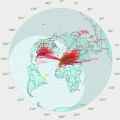ka7oei
About
- Username
- ka7oei
- Joined
- Visits
- 1,328
- Last Active
- Roles
- Member
- Points
- 2
-
DRM Heard
-
Advice on sharing RX antennas with 3 SDRs in the most effective way
It's worth mentioning that at a quiet location, even a KiwiSDR connected directly to a (nominally) unity-gain antenna is not quite sensitive enough to hear the IRU-defined noise floor - much less if it is split several ways. What this means is that unless some rather rugged amplification is included in the signal path, the KiwiSDR will not be able to hear signals near the thermal noise floor on the higher bands - say, >=20 MHz or so.
If your location is rather noisy to begin with, then there is no need to do through this trouble: This can be determined by tuning in a "blank" spot on 10 meters and observing the S-meter reading with and without (preferably substituting the antenna with a 50 ohm load) and seeing if there is an obvious difference - at least a couple dB, consistently higher with the antenna connected. If there is no obvious difference, your receive system is "gain starved".
I have found that with the Kiwis at the Northern Utah WebSDR - with an antenna that is essentially "flat" from 3-30 MHz (around 6dBi peak across this range), split four ways, around 20-ish dB cumulative signal gain is required to assure that the KiwiSDR can reliably "see" the thermal noise floor on 12-10 meters at this fairly quiet site - but there's a caveat to this: If you put this much gain in front of the KiwiSDR "naked", you will overload it on lower-frequency signals - that is, those below 12 MHz or so - when the bands open at night - and the receiver will overload badly, much of the "A/D" capacity being spent on a couple dozen strong signals at the expense of everything else.
For this reason, several in this group have devised "limited attenuation high-pass filters" where those lower-frequency signals are attenuated by a certain amount - something in the 10-20dB range: Enough to knock those very strong signals down significantly, but not enough to put the receiver below the (increasing inversely with frequency) natural noise floor.
You may peruse that thread here: http://forum.kiwisdr.com/discussion/comment/4490#Comment_4490
This allows amplification of the signals across the HF spectrum of a sufficient degree while considering the dynamics of those signals - and the dynamics of the KiwiSDR's A/D as well.
In the current configuration at the Northern Utah WebSDR, the signal path is along the lines of:
HF Antenna -> Lightning Protection -> 2-way splitter (the KiwiSDRs are on one of these branches) -> Adjustable AM-reject filter network -> High-dynamic range 14dB RF amplifier -> 2-way splitter -> Limited attenuation high-pass filter for Kiwis -> High-dyanamic range 14dB RF amplifier -> HF+LF Combiner -> 4-way splitter -> KiwiSDRs
A (slightly outdated) block diagram and more information about that signal path may be found here: http://utahsdr.org/info/rx_rf_distribution.html
The amplifier is described on this page: http://utahsdr.org/info/rx_softrock.html (See Figure 3 on this page and the other, similar amplifiers embedded in the diagrams of the other receivers.)
Note that the system at this WebSDR has been designed to use both narrowband "softrock" and wideband direct-sampling receivers, hence the two complete signal paths. The rationale for this was to "future-proof" the system: The narrow-band "softrock" receivers are still the best way to inexpensively get high performance, but the "wideband" receivers (KiwiSDRs) are still not suitable for many dozens of users - and the combination of affordable, very high performance hardware and the software for sharing many users on wideband receiver hardware is still a little ways off - but we expect it to be available in the next couple of years.
73,
Clint
KA7OEI



